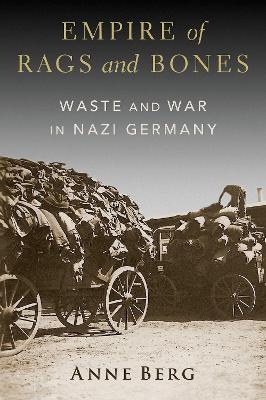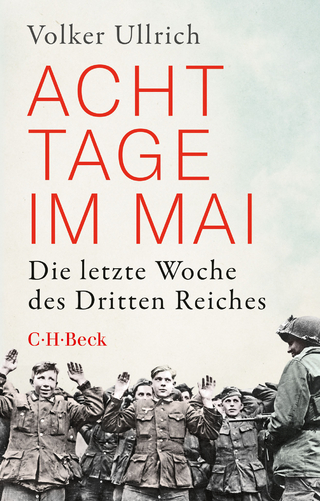
Empire of Rags and Bones
Waste and War in Nazi Germany
Seiten
2024
Oxford University Press Inc (Verlag)
978-0-19-774400-0 (ISBN)
Oxford University Press Inc (Verlag)
978-0-19-774400-0 (ISBN)
Empire of Rags and Bones offers a fresh perspective on the history of the Third Reich and the Nazi genocide of the Jews. Historicizing the much-championed ideal of zero waste, this book explains the connections between Nazi resource-thinking, imperial expansion, and racial purging.
Paper, bottles, metal scrap, kitchen garbage, rubber, hair, fat, rags, and bones--the Nazi empire demanded its population obsessively collect anything that could be reused or recycled. Entrepreneurs, policy makers, and ordinary citizens conjured up countless schemes to squeeze value from waste or invent new purposes for defunct or spent material, no matter the cost to people or the environment. As World War II dragged on, rescued loot--much of it waste--clogged transport routes and piled up in warehouses across Europe.
Historicizing the much-championed ideal of zero waste, Anne Berg shows that the management of waste was central to the politics of war and to the genesis of genocide in the Nazi Germany. Destruction and recycling were part of an overarching strategy to redress raw material shortages, procure lebensraum, and cleanse the continent of Jews and others considered undesirable. Fostering cooperation between the administration, the party, the German Army, the SS, and industry, resource extending schemes obscured the crucial political role played by virtually all German citizens to whom salvaging, scrapping, and recycling were promoted as inherently virtuous and orderly behaviors. Throughout Nazi occupied-Europe, Jews, POWs, concentration camp inmates, and enemy civilians were forced to recycle the loot, discards, and debris of the Nazi race war. In the end, the materials that were fully exploited and the people who had been bled dry were cast aside, buried, burned, or left to rot. Nonetheless, waste reclamation did not have the power to win the war.
Illuminating how the Nazis inverted the economy of value, rescuing discards and murdering people, Empire of Rags and Bones offers an original perspective on genocide, racial ideology, and World War II.
Paper, bottles, metal scrap, kitchen garbage, rubber, hair, fat, rags, and bones--the Nazi empire demanded its population obsessively collect anything that could be reused or recycled. Entrepreneurs, policy makers, and ordinary citizens conjured up countless schemes to squeeze value from waste or invent new purposes for defunct or spent material, no matter the cost to people or the environment. As World War II dragged on, rescued loot--much of it waste--clogged transport routes and piled up in warehouses across Europe.
Historicizing the much-championed ideal of zero waste, Anne Berg shows that the management of waste was central to the politics of war and to the genesis of genocide in the Nazi Germany. Destruction and recycling were part of an overarching strategy to redress raw material shortages, procure lebensraum, and cleanse the continent of Jews and others considered undesirable. Fostering cooperation between the administration, the party, the German Army, the SS, and industry, resource extending schemes obscured the crucial political role played by virtually all German citizens to whom salvaging, scrapping, and recycling were promoted as inherently virtuous and orderly behaviors. Throughout Nazi occupied-Europe, Jews, POWs, concentration camp inmates, and enemy civilians were forced to recycle the loot, discards, and debris of the Nazi race war. In the end, the materials that were fully exploited and the people who had been bled dry were cast aside, buried, burned, or left to rot. Nonetheless, waste reclamation did not have the power to win the war.
Illuminating how the Nazis inverted the economy of value, rescuing discards and murdering people, Empire of Rags and Bones offers an original perspective on genocide, racial ideology, and World War II.
Anne Berg is Assistant Professor of History at the University of Pennsylvania. She is the author of On Screen and Off: Cinema and the Making of Nazi Hamburg.
Acknowledgments
Abbreviations
Glossary
Introduction
Part I: Order
Chapter 1: The Nazi Waste Regime
Chapter 2: Garbage Visionaries
Chapter 3: Garbage Community
Part II: Extraction
Chapter 4: Forged in Metal
Chapter 5: Rag Farming
Chapter 6: Waste Cycles
Part III: Destruction
Chapter 7: Soap Bones
Chapter 8: Bombed-out and Trashed-in
Chapter 9: Piles
Conclusion: Hidden in Plain Sight
Notes
Bibliography
Index
| Erscheinungsdatum | 28.02.2024 |
|---|---|
| Zusatzinfo | 36 black and white halftones |
| Verlagsort | New York |
| Sprache | englisch |
| Maße | 150 x 226 mm |
| Gewicht | 680 g |
| Themenwelt | Geschichte ► Allgemeine Geschichte ► 1918 bis 1945 |
| Geisteswissenschaften ► Geschichte ► Regional- / Ländergeschichte | |
| Geschichte ► Teilgebiete der Geschichte ► Militärgeschichte | |
| ISBN-10 | 0-19-774400-1 / 0197744001 |
| ISBN-13 | 978-0-19-774400-0 / 9780197744000 |
| Zustand | Neuware |
| Haben Sie eine Frage zum Produkt? |
Mehr entdecken
aus dem Bereich
aus dem Bereich
ein Psychologe erlebt das Konzentrationslager
Buch | Hardcover (2024)
Kösel (Verlag)
22,00 €
Mythos „Stauffenberg-Attentat“ – wie der 20. Juli 1944 verklärt und …
Buch | Hardcover (2024)
Goldmann (Verlag)
24,00 €
die letzte Woche des Dritten Reiches
Buch | Softcover (2023)
C.H.Beck (Verlag)
16,00 €


